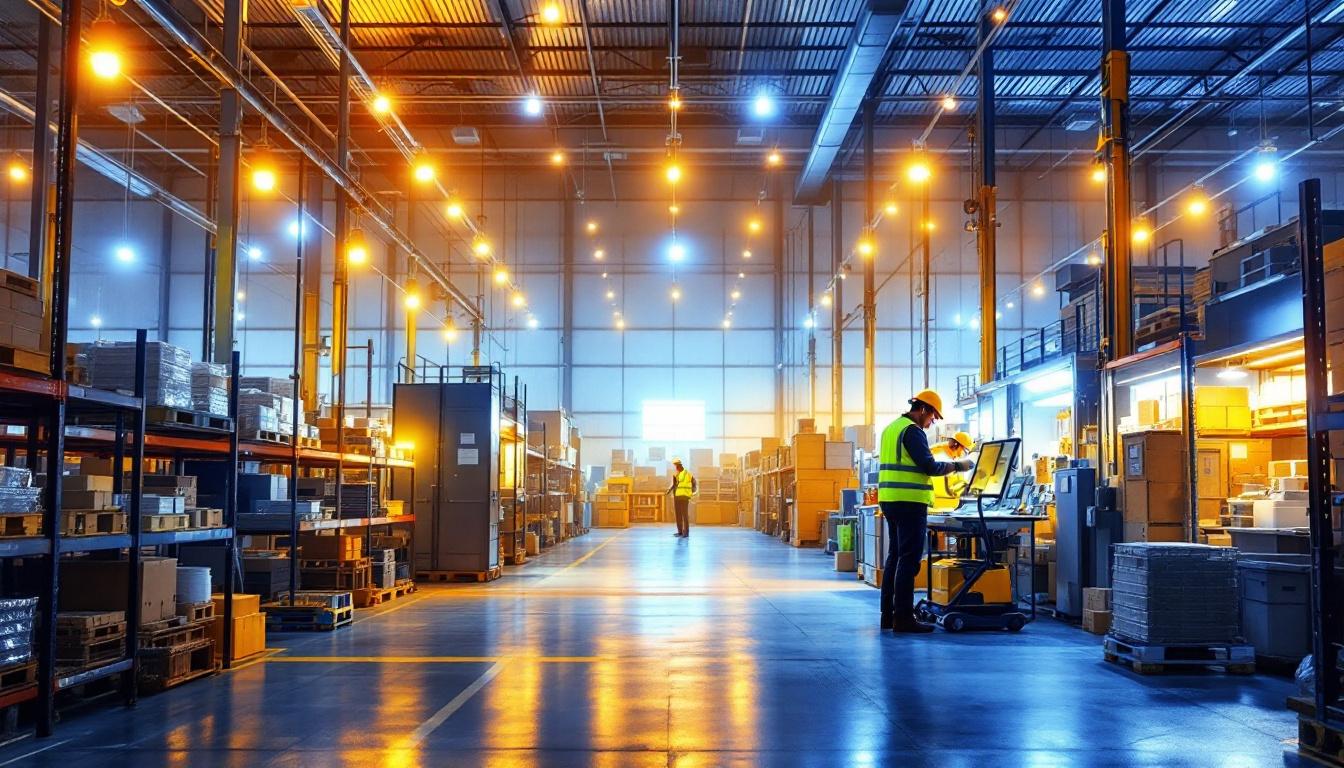
In the ever-evolving landscape of commercial spaces, effective lighting solutions play a pivotal role in enhancing operational efficiency and safety. For lighting contractors, understanding the nuances of commercial warehouse lighting can unlock numerous business benefits. This article delves into the various advantages that come with specializing in this area, highlighting the importance of tailored lighting solutions for warehouses and the positive impact they can have on both contractors and their clients.
Warehouses are unique environments that require specific lighting solutions to meet the demands of both the space and the activities conducted within it. Proper lighting not only ensures safety but also enhances productivity and efficiency. By focusing on the specific needs of warehouses, lighting contractors can provide solutions that significantly improve the overall functionality of these spaces.
One of the primary concerns in any warehouse setting is safety. Poor lighting can lead to accidents, injuries, and even costly legal issues. Effective warehouse lighting helps to illuminate pathways, work areas, and storage spaces, reducing the risk of accidents. Furthermore, many industries are subject to strict regulations regarding workplace safety, including lighting standards. By offering compliant lighting solutions, contractors can help businesses avoid penalties and ensure a safer working environment.
In addition to meeting regulatory requirements, well-lit warehouses contribute to employee morale. Workers are more likely to feel comfortable and secure in a well-lit environment, which can lead to increased job satisfaction and reduced turnover rates. This aspect is particularly important in industries with high labor demands, where retaining skilled workers is crucial for maintaining operational efficiency. Furthermore, studies have shown that employees who feel safe and valued in their work environment are often more engaged and motivated, leading to higher levels of productivity and better overall performance.
Lighting plays a critical role in influencing worker productivity. Studies have shown that appropriate lighting conditions can lead to enhanced focus and reduced fatigue. In a warehouse setting, where tasks often require precision and attention to detail, the right lighting can make a significant difference. By providing tailored lighting solutions, contractors can help businesses optimize their operations and improve overall efficiency.
Moreover, modern lighting technologies, such as LED systems, offer the potential for energy savings. By replacing outdated lighting with energy-efficient options, warehouses can reduce their energy consumption, resulting in lower utility bills. This not only benefits the bottom line but also aligns with sustainability goals, which are increasingly important to many businesses today. Additionally, advanced lighting systems can be integrated with smart technologies that allow for automated adjustments based on occupancy and natural light levels, further enhancing energy efficiency and creating a more adaptable workspace. These innovations not only contribute to cost savings but also promote a forward-thinking approach to warehouse management, positioning companies as leaders in their respective industries.
When it comes to warehouse lighting, there are several types of solutions that contractors can offer. Each type serves a different purpose and can be tailored to meet the specific needs of the warehouse environment. Understanding these options is essential for contractors aiming to provide the best possible service to their clients.
General lighting, or ambient lighting, is the foundation of any warehouse lighting plan. It provides overall illumination for the space, ensuring that all areas are adequately lit. This type of lighting is crucial for safety and visibility, allowing workers to navigate the warehouse without hazards. Common options for general lighting include high bay and low bay fixtures, which are designed to illuminate large areas effectively.
When selecting general lighting solutions, contractors should consider factors such as ceiling height, layout, and the specific activities taking place within the warehouse. By conducting a thorough assessment, contractors can recommend the most suitable fixtures that will provide optimal illumination while minimizing energy costs. Additionally, the use of smart lighting systems can enhance general lighting by allowing for automated adjustments based on occupancy or natural light levels, further optimizing energy efficiency and reducing operational costs.
Task lighting is designed to provide focused illumination for specific tasks or work areas within the warehouse. This type of lighting is essential for activities that require precision, such as picking, packing, or assembly. By strategically placing task lighting in key areas, contractors can enhance visibility and reduce the likelihood of errors.
LED task lights are a popular choice for warehouses due to their energy efficiency and long lifespan. Additionally, adjustable task lighting can be beneficial, allowing workers to direct light where it is needed most. By incorporating task lighting into their offerings, contractors can help businesses improve productivity and reduce the risk of accidents associated with poor visibility. Furthermore, the integration of motion sensors with task lighting can ensure that lights are only activated when needed, further enhancing energy savings and extending the life of the fixtures.
Emergency and exit lighting are critical components of warehouse safety. In the event of a power outage or emergency situation, these lights ensure that workers can safely exit the building. Compliance with safety regulations often mandates the installation of emergency lighting systems, making this an essential area for contractors to address.
Contractors should be well-versed in the requirements for emergency lighting, including placement, maintenance, and testing protocols. By offering comprehensive solutions that include emergency and exit lighting, contractors can provide added value to their clients and enhance the overall safety of the warehouse environment. Regular maintenance checks and testing of these systems are vital to ensure they function correctly when needed. Additionally, incorporating signage that is illuminated by emergency lighting can further guide workers to exits during an emergency, reinforcing the importance of a well-planned lighting strategy in safeguarding personnel and assets within the warehouse.
The advancement of lighting technology has transformed the way warehouses are illuminated. Contractors who stay informed about the latest innovations can offer cutting-edge solutions that meet the evolving needs of their clients. Embracing technology not only enhances the quality of lighting solutions but also positions contractors as industry leaders.
Smart lighting systems are becoming increasingly popular in commercial settings, including warehouses. These systems allow for automated control of lighting based on occupancy, time of day, and natural light availability. By implementing smart lighting solutions, contractors can help businesses reduce energy consumption and improve operational efficiency.
For example, motion sensors can automatically turn lights on or off in unoccupied areas, ensuring that energy is not wasted. Additionally, smart lighting can be integrated with building management systems, providing real-time data on energy usage and lighting performance. This level of control and insight can lead to significant cost savings and improved sustainability.
LED lighting has revolutionized the commercial lighting industry, offering numerous advantages over traditional lighting options. LEDs are highly energy-efficient, have a longer lifespan, and require less maintenance. For warehouses, this translates into reduced energy costs and less frequent replacements, making them a cost-effective choice for lighting contractors.
Moreover, LED technology is versatile, with options available for general, task, and emergency lighting. By promoting LED solutions, contractors can provide clients with a comprehensive lighting strategy that maximizes efficiency and minimizes operational costs. As more businesses prioritize sustainability, the demand for LED lighting solutions is expected to grow, presenting a significant opportunity for contractors.
In the competitive landscape of lighting contracting, building strong relationships with clients is essential for long-term success. By understanding the unique needs of each warehouse and providing tailored lighting solutions, contractors can establish themselves as trusted partners in their clients’ operations.
A consultative approach is key to understanding the specific requirements of each warehouse. By conducting thorough assessments and engaging in open dialogue with clients, contractors can identify pain points and recommend solutions that address their needs. This level of attention not only fosters trust but also positions contractors as experts in their field.
Furthermore, ongoing communication throughout the project lifecycle ensures that clients feel supported and informed. Regular updates, feedback sessions, and post-installation follow-ups can enhance client satisfaction and lead to repeat business and referrals.
Educating clients about the benefits of various lighting solutions can empower them to make informed decisions. Contractors who take the time to explain the advantages of different technologies, such as LED and smart lighting, can help clients understand the long-term value of their investment. Additionally, offering training on how to operate and maintain lighting systems can further strengthen the client-contractor relationship.
By positioning themselves as knowledgeable resources, contractors can build credibility and trust, ultimately leading to stronger client relationships and increased business opportunities.
As the demand for efficient and effective warehouse operations continues to grow, the role of lighting contractors becomes increasingly important. By specializing in commercial warehouse lighting, contractors can provide valuable solutions that enhance safety, productivity, and efficiency. Understanding the various lighting options, leveraging technology, and building strong client relationships are essential components of success in this field.
In a landscape where businesses are constantly seeking ways to optimize their operations, lighting contractors have a unique opportunity to make a significant impact. By staying informed about industry trends and advancements, contractors can position themselves as leaders in commercial warehouse lighting, ultimately benefiting their clients and their own businesses.
In conclusion, the future of warehouse lighting is bright, and those who embrace innovation and prioritize client relationships will undoubtedly thrive in this dynamic industry.
Ready to elevate your warehouse lighting projects and outshine the competition? Look no further than LumenWholesale, where we offer an extensive range of top-quality, spec-grade lighting products at unbeatable wholesale prices. Say goodbye to local distributor markups and hello to superior lighting solutions that meet the highest industry standards. With LumenWholesale, you’ll enjoy the convenience of bulk buying with free shipping, ensuring you get premium lighting at the best value — without hidden fees or compromises. Don’t miss out on the perfect blend of quality, affordability, and convenience. Take the next step in optimizing your commercial warehouse lighting services by visiting Wholesale Lighting at the Best Value today.

Discover why the 120V 60Hz light bulb is a crucial component for lighting contractors.

Discover essential insights and expert tips tailored for lighting contractors in this comprehensive guide.

Discover essential conduit wire puller tips for lighting contractors to boost efficiency, reduce installation time by up to 30%, and ensure safe, seamless wiring—get expert insights now!.

Discover the transformative impact of hanging LED lights for lighting contractors.